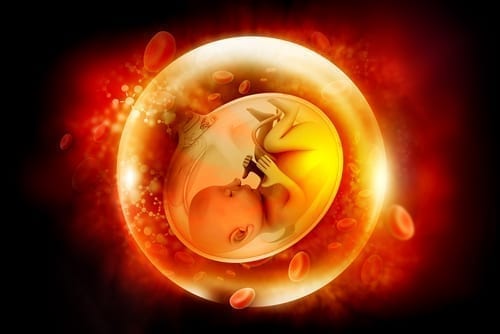
By the end of the 19th century, it had become clear to science that the human brain produces measurable electrical currents. This discovery eventually led to the electroencephalograph (EEG), a device which enables doctors to measure the electrical activity in the brain, through electrodes attached to the head.
It is obvious that when a person dies, the brain ceases to function, which is represented on an electroencephalogram as a straight line, devoid of the waves and peaks that signal brain activity. Based upon this observation, scientists have suggested that the onset of human life can also be defined by brainwaves; that is, the day when the brain begins to function and emit electrical currents. For if an EEG displaying no brain activity testifies to the death of a person, then, the beginning of brain activity must testify to the fact that a fetus is a living human being in every way.
The challenge inherent in this idea lies in determining the exact day when electrical activity in the brain of a fetus begins – a challenge that no scientific researcher had attempted to confront. Who could imagine the possibility of testing the brain function of a fetus, whose body was the size of a bean, and brain the size of a pinhead?
This situation existed for much of the 20th century. By the end of the century, however, technology advanced to the point that such experimentation became possible. Professor David Lygre, of the Central Washington University, author of Life Manipulation, is considered one of the leading experts in the field. He writes: “We do not know much about the development of the brain of the fetus… until about the fortieth day of life, at which point the basic structure of the brain is in place, and it becomes possible to discern slight electrical activity.”
The identical conclusion – though from a different perspective – was reached by a team of British scientists, who published their results in New Scientist. According to this study, fetuses can experience pain from approximately the fortieth day of life onward. In the conclusions of their findings, they suggest that all women considering an abortion should be informed of this discovery, and that, laws for protecting the rights of fetuses should be established. Publication of the article resulted in major protests against abortion practitioners.
In light of this, it is clear to scientists that at around the fortieth day after conception, the fetus gains the status of a complete human being – a living and feeling entity like any one of us. This further implies that even according to science, the act of abortion – or “terminating pregnancy” as it is sometimes called (in order to silence human and particularly maternal conscience) – can actually be considered an act of murder!
This is truly a unique and interesting discovery. But could it be possible that the Creator of the Universe would leave us without knowledge about an issue so crucial to human life, until technological advances of the late 20th century allowed us to measure the brain’s activity? Or would God, as Creator of man and author of the Torah, reveal to us this essential information within the context of Jewish law?
The following Mishnah (Niddah 3:7) deals with the ritual purity of a woman who experienced a miscarriage. It draws a distinction between a fetus that was lost before it was considered a complete entity and one that was lost after it was considered human in every way:
“A miscarriage up to the fortieth day is not considered an embryo [in matters of ritual purity].
[If a miscarriage occurs] from the forty-first day, she [the mother] is ritually impure…”
How did the Mishnah, composed two thousand years ago, know information that was only discovered at the beginning of the twenty-first century using the most advanced equipment in the world?
It is worth noting that even today, scientists have not yet determined the exact day upon which the fetus can be considered fully human. Professor Lygre merely stated that it is “approximately the fortieth day.”
Thousands of years ago the Mishnah already gave us an exact answer.
What is the source of this knowledge?
For us, the answer is clear.
***
In any situation in which the question of abortion arises during pregnancy – such as in the case when medical opinion recommends abortion – a competent rabbi must be consulted for a halachic decision. This is true even in cases when a fetus has not yet reached the age of forty days.
According to the Kabbalah, a fetus receives its soul with the first three days after conception. This spiritual force illuminates it and engenders its growth. Without this, the ovum would simply decay. Terminating pregnancy even at an early stage is thus considered snuffing out the soul of a human being. See Rabbi Isaac Luria, Otzrot Chayim, Sha’ar A’nach , chap. 3.
It should also be noted that there have been countless cases when doctors recommended abortion due to predicted birth defects or retardation, yet were proven wrong when an intelligent, healthy child was born. And even in the event that they were correct, it is forbidden to kill a fetus that shows signs of birth defects, just as it is unthinkable to kill an adult human being who suffers from such disabilities. While Jewish law does allow for abortion in unique and limited cases, it is only after the approval of qualified rabbinic authorities.
It is also vital to make clear that in many cases when a mother was told that a fetus was dead and should be removed, it turned out, upon further examination, that it was actually alive!
Adapted from The Revolution by Rabbi Zamir Cohen
